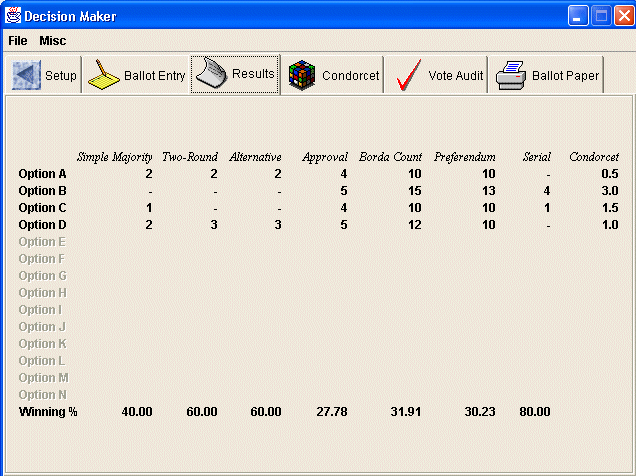The electorate decides...
Let us assume that the ballots have been printed and distributed and that an electorate of five persons - Messrs J, K, L, M and N - have voted by giving a 1 to their first preference, a 2 to their second preference, and so on.
Let us imagine that they voted as follows:
|
Preferences |
Ms. J |
Mr. K |
Ms. L |
Mr. M |
Ms. N |
|
1st |
A |
A |
D |
D |
C |
|
2nd |
B |
B |
B |
B |
B |
|
3rd |
C |
C |
- |
C |
D |
|
4th |
D |
D |
- |
A |
A |
Please note that Ms L only gave her first and second preferences; but that, of course, is her prerogative and is accepted by the software package.
Determining the final results...
An analysis of the votes according to eight different voting methodologies is as follows:

The methodologies are mentioned here and described in the analysis.
Majority (Plurality) Voting is used in most parliaments and most referendums.
Two-Round Voting is used in some referendums, eg, in New Zealand.
Approval Voting is sometimes used in the UN, though mainly as an electoral system.
Alternative Vote is used in Austraoian elections and, in its PR form, in elections in Ireland, North and South.
The Borda Count is a French methodology, used in part in Slovenian elections, to analyse the ethnic vote.
The Modified Borda Count, which is actually Jean-Charles de Borda's original formula, allows for partial voting in the Borda count.
Serial Voting is used in some Scandinavian parliaments, eg, in Sweden.
A Condorcet count is another French methodology.
All of these methodologies are described as democratic, yet in many instances, different counting procedures will lead to different results. In our own example, the ‘most popular’ options are:
|
VOTING PROCEDURE |
WINNER(S) |
RUNNER(S)-UP |
|
Plurality Voting |
A and D = |
|
|
Two-round voting |
D |
A |
|
Alternative Vote (AV) or STV |
D |
A |
|
Approval Voting |
B and D = |
|
|
Borda Count (BC) |
B |
D |
|
Modified Borda Count (MBC) or Preferendum |
B |
A, C and D = |
|
SerialVoting |
B |
C |
|
Condorcet |
B |
C |
In analysing the vote, we must examine each methodology in turn. But first, we repeat the voters' profile, like this:
|
Preferences |
Ms. J |
Mr. K |
Ms. L |
Mr. M |
Ms. N |
|
1st |
A |
A |
D |
D |
C |
|
2nd |
B |
B |
B |
B |
B |
|
3rd |
C |
C |
|
C |
D |
|
4th |
D |
D |
|
A |
A |
or in a slightly different style.
|
|
Preferences of: |
||||
|
Options |
Ms. J |
Mr. K |
Ms. L |
Mr. M |
Ms. N |
|
A |
1st |
1st |
- |
4th |
4th |
|
B |
2nd |
2nd |
2nd |
2nd |
2nd |
|
C |
3rd |
3rd |
- |
3rd |
1st |
|
D |
4th |
4th |
1st |
1st |
3rd |
Majority (Plurality) Voting considers only the first preferences, so while two people consider option A to be the best, and hence its score of two, the fact that two other people think it is the worst is not taken into account.
Two-Round Voting takes the two leading options from the plurality vote, and takes a straight majority vote between the two. Messrs J and K prefer A to D but Messrs L, M and N all prefer D to A, so D wins by 3 to 2.
In the Alternative Vote, option B is again (as in the plurality vote) considered to be the worst with a score of 0. Option C is the next least popular, and when its vote is transferred according to Mr. M's preferences, it goes to D. So D wins.
In Approval Voting, any preference expressed is regarded as a mark of approval, so in this analysis Options B and D gain the maximum score of 5 approvals.
A Borda Count is a straight points system with, in this instance, 4 points for a first preference, 3 for a second, and so on. And B wins.
In a Borda Preferendum, a partial vote is given a correspondingly partial score but, in this instance, the winner is still B.
Serial Voting considers the four options as if on an axis, and takes a majority vote between the two extremes first: A v D. A loses, so its then B v D. B wins this vote, so it's then B v C and again, B is the winner.
A Condorcet count is a series of pairings - A v B, A v C, A v D, B v C, B v D and C v D; the options which wins the most pairings is the winner and, in our example, it is again B.


